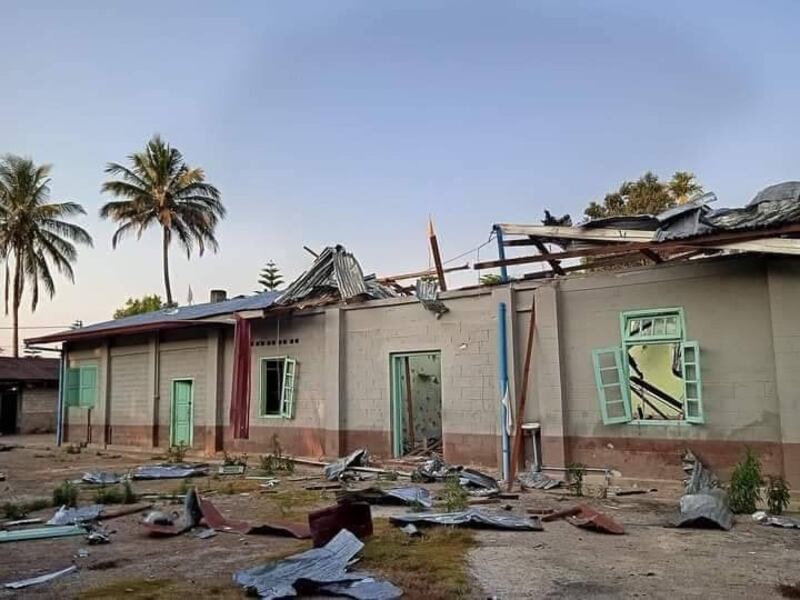Troops loyal to Myanmar’s junta have destroyed at least 132 religious buildings in arson and other attacks in wartorn Sagaing and Magway regions and Chin and Kayah states in the 17 months since the military seized power, RFA Burmese has learned.
A list compiled by RFA, based on information obtained from residents by rights groups, shows that the military destroyed a total of 33 religious buildings — 28 Buddhist monasteries, a Buddhist convent, two mosques, and two churches — in Sagaing between the Feb. 1, 2021, takeover and the end of June this year, as well as 11 Buddhist monasteries and a church in Magway.
Junta troops destroyed at least 66 churches in Chin state alone, and 20 churches and a mosque in Kayah state.
Data shows that, of the 28 Buddhist monasteries destroyed in Sagaing, most were located in Pale township, where the military has clashed with anti-junta People’s Defense Force (PDF) paramilitaries in some of the heaviest fighting since the coup.
A Buddhist abbot in Pale, who spoke to RFA on condition of anonymity citing reasons of security, said that the clergy have been unable to peacefully carry out their religious duties and are “struggling to survive” under the military regime.
“Our monasteries have been burnt down. We are only able to live here because people in the area built a place for us,” he said.
“[The military] has set fire to the villages and monasteries, so it is no longer possible to practice religion or work for the ‘Sasana’ (the teaching of Buddhism). These days, we must always be ready to be on the run for our lives.”
The abbot said that soldiers had come to his monastery in Pale and stolen all of the cash donations and other items in the monastery, as well as his personal savings and money sent by the national Monastic School Association. They even made off with a 200-year-old golden Buddha statue embellished with a sizable ruby, he added.
Other reports from Sagaing said that, in addition to religious buildings destroyed by arson, pagodas in many of the region’s villages had been severely damaged by shrapnel and small arms fire resulting from military raids.
In Magway, a resident of Saw township, who also declined to be named, told RFA that the military’s destruction of religious buildings in the area had become “routine.”
“There is no religion for them. They kill civilians and destroy religious structures without feeling any remorse,” he said.
“In addition to arresting and killing civilians, they [take] away all the valuables and things they [find] in the monastery. These acts have become routine for them. They are doing all this because they have no supplies coming from behind the frontlines.”
RFA has received frequent reports of arrests, looting, rape, torture, arson and murder amid scorched earth offensives by the military against the PDF and other anti-junta in Myanmar’s remote border regions. Junta forces have killed at least 2,069 civilians and arrested more than 14,500 since the coup, mostly during peaceful anti-coup protests, according to Thailand’s Assistance Association for Political Prisoners.
Chin and Kayah states
According to information compiled by RFA, the most churches destroyed by the military since the coup were located in Chin state, with 66 buildings targeted in the townships of Thantlang, Hakha, Tedim, Falam, Mindat, Kanpetlet and Matupi.
Dennis Ngun Thang Mang, the chairman of the Chin Baptist Association, told RFA that the military is “deliberately targeting” religious buildings in Chin state.
“We feel very sad that our religious buildings, the most sacred places for us, were destroyed,” he said.
“We condemn these acts. Targeting these buildings is unforgivable and should not have happened. Maybe 5% of the incidents were accidental. But I think their actions were nearly all deliberate.”
A statement from the Chin Affairs Federation in March noted that not only were churches being targeted in Chin state, but at least 20 pastors had also been arrested in the region, four of whom were killed. The group said that while 12 were eventually released, the other four remain in detention.
A spokesman for the ethnic Progressive Karenni People's Movement told RFA that 21 religious buildings were damaged in the Kayah state townships of Loikaw, Demoso and Hpruso since February 2021.
A member of the clergy in Loikaw slammed what he called the “intentional destruction” of Christian buildings in the state.
“No matter how intense the war, they cannot attack temples and schools,” he said. “We can understand accidental destruction, but intentional attacks and arson should not have happened at all.”

Documenting evidence for prosecution
Repeated attempts by RFA to contact Maj. Gen. Zaw Min Tun, the junta’s deputy minister of information, for comment on the destruction went unanswered. However, the junta spokesman has previously denied that the military intentionally targets religious buildings.
Aung Myo Min, minister for human rights for the shadow National Unity Government, called on residents to document such acts by junta troops for future prosecution.
“If cases aren't properly documented now, the evidence cannot be substantiated when it is needed to establish the truth later on,” he said.
“Therefore, please gather information on all violations and atrocities and crimes — even if it is painful to do so. It’s necessary to record exactly what happens and systematically document who the perpetrators are, including from which battalion. I want to urge the victims to become witnesses in the future.”
Aung Myo Min said that although international laws based on the so-called Geneva Conventions prohibit attacks on religious buildings, the military has deliberately destroyed them as part of its crackdown on the armed opposition.
While most of the 132 religious buildings were reported as having been destroyed by arson, several were damaged by heavy weapons. Residents and religious leaders told RFA that they regularly saw soldiers storm the buildings before deliberately destroying them.
Translated by Khin Maung Nyane. Written in English by Joshua Lipes.
